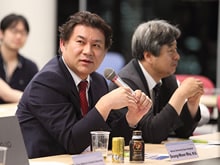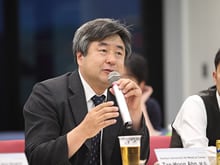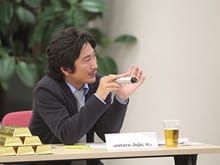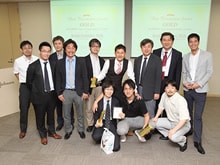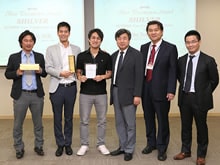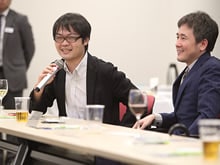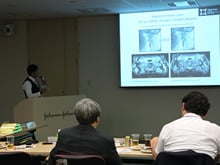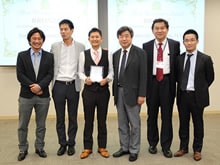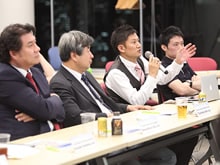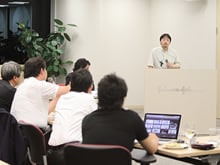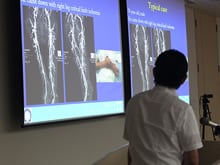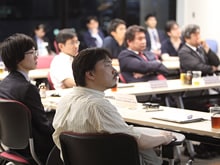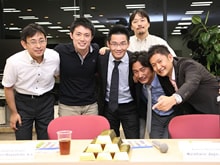Case Competition @TOPICのご報告
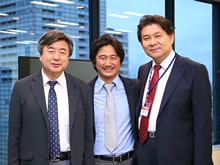
TOPIC2014開催に合わせて、Special Gest Commentatorとして、韓国のEVT界ビッグネームであるTae-Hoon Ahn先生(Korea University Guro Hospital)、Seung-Woon Rha先生(Korea University Guro Hospital)をお招きして、EVT Case Competitionを開催致しました。
本会中は参加者全員がすべて英語のみ、6名の先生方によるプレゼンテーションおよびディスカッションは大いに盛り上がりました。3時間もの長丁場にも関わらず、全員参加の大変熱く楽しい時間となりました。『Best Presentation Award』は、上記2名のGest CommentatorとSUNRISE世話人による採点のもと、Gold、Silver、Bronzeを表彰させていただきました(皆さん甲乙つけ難く審査も難渋しました)。
SUNRISE.labでは、今後も同様の機会を企画・開催していきます。参加者の皆さんにも大好評、必ず何かを得られる会になります。今回参加できなかった皆様も次回奮ってご参加ください。
以下は『Best Presentation Award』に輝いた3名の先生方のプレゼンテーションです。ご参考ください。
【Best Presentation Award】Gold
Successful percutaneous Transluminal angioplasty for common
femoral artery stenosis treated with intra plaque ballooning
吉岡 賢二 先生(亀田メディカルセンター循環器内科)
 Abstract
Abstract
A 75-year-old female was referred to our clinic for her right leg
intermittent claudication. Both ABI were decreased (right:0.57, left:0.63),
and CT showed substantial calcification on both common femoral
arteries (CFA). Angiogram showed eccentric stenosis on her right CFA,
and we performed transluminal ballooning to the lesion, and the pressure
gradient disappeared immediately after the angioplasty. However, ABI
did not change, and the symptom relapsed in 2 months. Two months
after the first PTA, angiography was performed and it revealed lesion
recoil. Given the unsuccessful short-term result, we changed the strategy,
penetrating the guide-wire into the center of the plaque, and inflated a
balloon within the plaque. After the procedure, the ABI improved
(right:0.76) and the symptom disappeared, and ABI was still maintained
to the same level in 10 months after the procedure.
PTA to CFA is challenging because stenting is not favorable. For lesions
with eccentric plaque, transluminal ballooning is not effective since the
lesion easily recoils. We used intra plaque ballooning technique for the
eccentric plaque in the right CFA, which has been successful. These
findings suggest that intra plaque ballooning might be more effective for
lesions with eccentric plaque than transluminal ballooning.
【Best Presentation Award】Silver
Successful Carotid Artery Stenting in patient with inaccessible
shagggggy aortic arch
鳥居 翔 先生(東海大学 循環器内科)
 Abstract
Abstract
A 65-years-old woman with hypertension, dyslipidemia, diabetes, and
past smoking had planned to undergo total arch replacement for TAA.
However, chest CT and carotid echo showed that occluded right internal
carotid artery, and 70% stenosis in left internal carotid artery with
increased peak systolic velocity (250cm/sec). Head MRI showed the old
cerebral infarction in left side. We decided to treat her left carotid artery
first, because neurologist alerted that the risk of stroke in perioperative
period would be high.
However, carotid artery stenting (CAS) to this patient was at a high risk
for embolic stroke due to her diseased aortic arch. In addition, carotid
endarterectomy was not feasible and safe because of contralateral
carotid artery occlusion, and severe COPD. This is why we decided to
perform “hybrid” procedure, transcervical CAS.
Transcervical CAS was performed successfully and she discharged 3
days after the procedure. Transcervical CAS could be one of the choices
for the carotid artery stenosis especially for the patients with aortic
aneurysm.
【Best Presentation Award】Bronze
Black-blood magnetic resonance imaging(BB-MRI) could indicate
the stability of the plaque and help us to perform carotid artery stenting(CAS) more safely
梅本 朋幸 先生(武蔵野赤十字病院 循環器科)
 Abstract
Abstract
Aims:
Distal embolism inducing stroke is the one of the most terrible complication
during CAS. When we could know which plaque is vulnerable before the
procedure, we can choice the feasible protection method. So the aim of the
present study is to elucidate whether BB-MRI of plaque could indicate the
plaque stability.
Methods and results:
We evaluated the consecutive 25 patients (27 cases) who were undergone CAS
from July 2010 to December 2013. In 23 patients (24 cases), BB-MRI with T1
weighted image (T1WI), T2 weighted image (T2WI) and time of flight (TOF) was
taken prior to the CAS. Average age was 72 and 4 patients (14.8 %) were
octogenarian. Twenty-two patients (81.5 %) were male gender. We perform CAS
with distal protection using filter in 2 cases and with proximal protection in 22
cases. Precise stent was used in 4 cases, and Carotid wall stent in 20 cases.
When debris was observed at the filter or stop/slow flow phenomenon occurred
or plaque protrusion was seen by intravascular ultrasound after stenting in the
course of CAS, the case was defined as unstable. Plaque protrusion was seen in
2 cases (18.5%) and additional stent was needed in 1 case. In 11 cases (40.7 %),
debris was trapped at the filter. We calculated the ratio of the intensity of the
plaque and sternocleidomastoid muscle (P/S) in the same slice. We evaluated
the value of P/S in the unstable cases (group U, n = 15) and the stable cases
(group S, n = 9). The value of P/S in T1WI was significantly higher in the group U
than group S (1.43 ± 0.23 and 0.85 ± 0.41, p value = 0.0017).
Conclusions:
The plaque with high P/S value in T1WI could be vulnerable and induce embolic
complication. We should consider the proximal protection or consult a vascular
surgeon for CEA.


